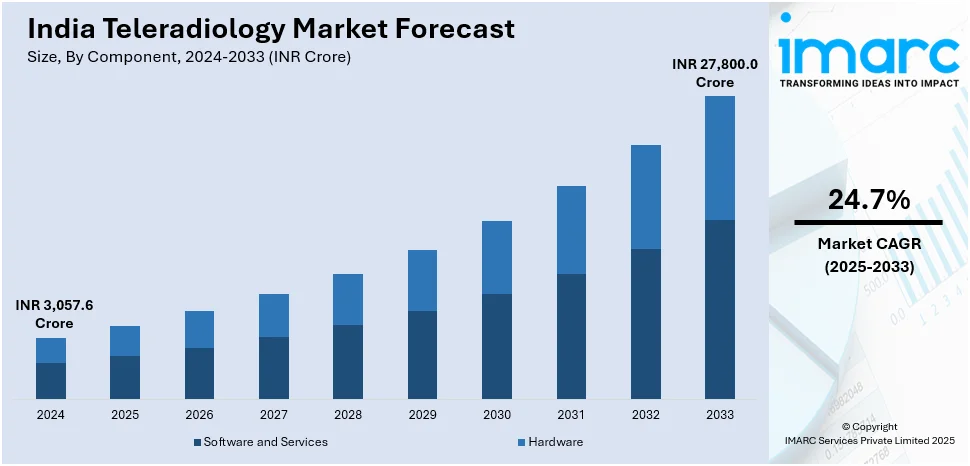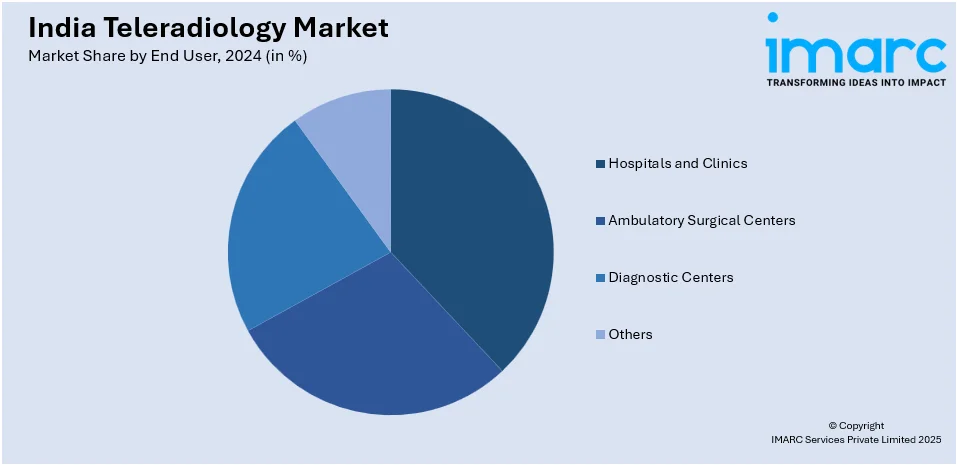
India Teleradiology Market Size, Share, Trends and Forecast by Component, Imaging Technique, End User, and Region, 2025-2033
Market Overview:
The India teleradiology market size reached INR 3,057.6 Crore in 2024. Looking forward, IMARC Group expects the market to reach INR 27,800.0 Crore by 2033, exhibiting a growth rate (CAGR) of 24.7% during 2025-2033. The growing demand for remote medical services, rising health consciousness among the masses, rising preference for remote care among the masses and favorable government initiatives to upgrade the overall healthcare infrastructure represent some of the key factors driving the market.
|
Report Attribute
|
Key Statistics
|
|---|---|
|
Base Year
|
2024 |
|
Forecast Years
|
2025-2033
|
|
Historical Years
|
2019-2024
|
| Market Size in 2024 | INR 3,057.6 Crore |
| Market Forecast in 2033 | INR 27,800.0 Crore |
| Market Growth Rate (2025-2033) | 24.7% |
Teleradiology is a medical imaging technique that involves the transmission of medical images, such as x-rays, MRIs, and CT scans, between two or more locations. It allows physicians to diagnose patients from a remote location and provide them with better access to medical care by accessing and reviewing patient images without having to travel to the patient’s location. Additionally, it can help to reduce backlogs of imaging studies and provide timelier diagnosis and treatment. Besides this, it assists physicians in consulting with other experts in their field, as well as providing second opinions in case of difficult diagnoses. In recent years, teleradiology has become more popular due to the easy accessibility of digital imaging, which enables the quick transmission of medical images in multiple locations. Moreover, it aids in reducing the costs associated with the diagnostic process, as the need for travel is eliminated. It is essential in rural areas, as it allows medical professionals to access medical imaging from distant locations. As a result, it is considered an important technology in the medical field, since it improves access to medical care and provides improved diagnostic accuracy in a cost-efficient manner.

To get more information on this market, Request Sample
India Teleradiology Market Trends:
The rising preference for remote care among the masses majorly drives the market in India. Since teleradiology is a convenient, secure, and cost-effective way to access medical imaging and radiology services, that offer patients easy access to medical care, especially in rural and underserved areas, this is propelling the market. As healthcare costs continue to rise, the demand for cost-effective medical services is growing, which, in turn, is catalyzing the demand across the country as teleradiology offers an affordable way to access quality medical imaging and radiology services, allowing healthcare providers to save money and increase patient satisfaction. Along with this, the rising need for timely and early diagnosis and treatment of numerous types of acute diseases is impacting the market favorably. Apart from this, numerous government agencies are heavily investing in teleradiology services in order to improve access to care and reduce healthcare costs, is positively influencing the market. Moreover, continual technological advancements, such as the introduction of cloud computing and artificial intelligence (AI) that provide healthcare providers with greater access to medical imaging and radiology services, is creating a positive market outlook.
Key Market Segmentation:
IMARC Group provides an analysis of the key trends in each sub-segment of the India teleradiology market report, along with forecasts at the country and regional level from 2025-2033. Our report has categorized the market based on component, imaging technique and end user.
Component Insights:
- Software and Services
- Hardware
The report has provided a detailed breakup and analysis of the India teleradiology market based on component. This includes software and services, and hardware. According to the report, services represented the largest segment.
Imaging Technique Insights:
- X-rays
- Computed Tomography (CT)
- Ultrasound
- Magnetic Resonance Imaging (MRI)
- Nuclear Imaging
- Others
A detailed breakup and analysis of the India teleradiology market based on the imaging technique has also been provided in the report. This includes x-rays, computed tomography (CT), ultrasound, magnetic resonance imaging (MRI), nuclear imaging, and others. According to the report, x-rays accounted for the largest market share.
End User Insights:

- Hospitals and Clinics
- Ambulatory Surgical Centers
- Diagnostic Centers
- Others
The report has provided a detailed breakup and analysis of the India teleradiology market based on end user. This includes hospitals and clinics, ambulatory surgical centers, diagnostic centers, and others. According to the report, hospitals and clinics represented the largest segment.
Region Insights:
- North India
- West and Central India
- South India
- East India
The report has also provided a comprehensive analysis of all the major regional markets, which include North India, West and Central India, South India, and East India.
Competitive Landscape:
The report has also provided a comprehensive analysis of the competitive landscape in the India teleradiology market. Competitive analysis such as market structure, market share by key players, player positioning, top winning strategies, competitive dashboard, and company evaluation quadrant has been covered in the report. Also, detailed profiles of all major companies have been provided, including:
- Agfa-Gevaert Group
- Everlight Radiology
- GE Healthcare
- Koninklijke Philips NV
- Apollo TeleHealth
- 5C Network (INDIA) Pvt Ltd.
- RxDx Healthcare
- Teleradiology Solutions
- Technidoc
- Oshin Infotech Services Private Limited
Report Coverage:
| Report Features | Details |
|---|---|
| Base Year of the Analysis | 2024 |
| Historical Period | 2019-2024 |
| Forecast Period | 2025-2033 |
| Units | INR Crore |
| Segment Coverage | Component, Imaging Technique, End User, Region |
| Region Covered | North India, West and Central India, South India, East India |
| Companies Covered | Agfa-Gevaert Group, Everlight Radiology, GE Healthcare, Koninklijke Philips NV, Apollo Telehealth, 5C Network (INDIA) Pvt Ltd., RxDx Healthcare, Teleradiology Solutions, Technidoc, Oshin Infotech Services Private Limited, etc. |
| Customization Scope | 10% Free Customization |
| Post-Sale Analyst Support | 10-12 Weeks |
| Delivery Format | PDF and Excel through Email (We can also provide the editable version of the report in PPT/Word format on special request) |
Key Benefits for Stakeholders:
- IMARC’s report offers a comprehensive quantitative analysis of various market segments, historical and current market trends, market forecasts, and dynamics of the India teleradiology market from 2019-2033.
- The research study provides the latest information on the market drivers, challenges, and opportunities in the India teleradiology market.
- The study maps the leading, as well as the fastest-growing, regional markets. It further enables stakeholders to identify the key state-level markets within each region.
- Porter's five forces analysis assist stakeholders in assessing the impact of new entrants, competitive rivalry, supplier power, buyer power, and the threat of substitution. It helps stakeholders to analyze the level of competition within the India teleradiology industry and its attractiveness.
- Competitive landscape allows stakeholders to understand their competitive environment and provides an insight into the current positions of key players in the market.
Key Questions Answered in This Report
The teleradiology market in the India was valued at INR 3,057.6 Crore in 2024.
The India teleradiology market is projected to exhibit a CAGR of 24.7% during 2025-2033, reaching a value of INR 27,800.0 Crore by 2033.
The India teleradiology market is driven by the rising demand for remote medical imaging services, shortage of radiologists, and the need for faster diagnosis. Increasing adoption of digital healthcare, advancements in telecommunication infrastructure, and growing awareness about early disease detection also offer a favorable market outlook. Cost-effectiveness and improved healthcare access in rural areas further support the market growth.
Some of the major players in the India teleradiology market include Agfa-Gevaert Group, Everlight Radiology, GE Healthcare, Koninklijke Philips NV, Apollo Telehealth, 5C Network (INDIA) Pvt Ltd., RxDx Healthcare, Teleradiology Solutions, Technidoc, Oshin Infotech Services Private Limited, etc.
Need more help?
- Speak to our experienced analysts for insights on the current market scenarios.
- Include additional segments and countries to customize the report as per your requirement.
- Gain an unparalleled competitive advantage in your domain by understanding how to utilize the report and positively impacting your operations and revenue.
- For further assistance, please connect with our analysts.
 Request Customization
Request Customization
 Speak to an Analyst
Speak to an Analyst
 Request Brochure
Request Brochure
 Inquire Before Buying
Inquire Before Buying




.webp)




.webp)












